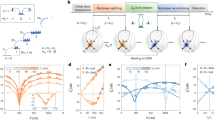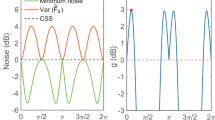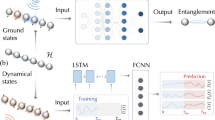Abstract
Squeezing and entanglement play crucial roles in approaches for quantum metrology. Yet, demonstrating quantum enhancement in continuous signal tracking remains a challenging endeavour because simultaneous entanglement generation and signal perturbations are often incompatible. We demonstrate that concurrent steady-state spin squeezing and sensing are possible using continuous quantum non-demolition measurements under constant optical pumping. We achieve a sustained spin-squeezed state with a large ensemble of hot atoms using metrologically relevant steady-state squeezing. We further employ the system to track different types of continuous time-fluctuating magnetic fields, and we demonstrate the use of deep learning models to infer the time-varying fields from an optical measurement. The quantum enhancement due to spin squeezing was verified by a degraded performance in test experiments where the spin squeezing was deliberately prevented. These results represent an advance in continuous quantum-enhanced metrology with entangled atoms, including the training and application of a deep neural network to infer complex time-dependent perturbations.
This is a preview of subscription content, access via your institution
Access options
Access Nature and 54 other Nature Portfolio journals
Get Nature+, our best-value online-access subscription
27,99 € / 30 days
cancel any time
Subscribe to this journal
Receive 12 print issues and online access
269,00 € per year
only 22,42 € per issue
Buy this article
- Purchase on SpringerLink
- Instant access to full article PDF
Prices may be subject to local taxes which are calculated during checkout




Similar content being viewed by others
Data availability
The data supporting the findings of this study are included in the paper and its Supplementary Information. The DL training data used in this study are available via Figshare at https://doi.org/10.6084/m9.figshare.25623525.v1 (ref. 62).
Code availability
The DL code for this study is available via Figshare at https://doi.org/10.6084/m9.figshare.25623525.v1 (ref. 62).
References
Pezzè, L., Smerzi, A., Oberthaler, M. K., Schmied, R. & Treutlein, P. Quantum metrology with nonclassical states of atomic ensembles. Rev. Mod. Phys. 90, 035005 (2018).
Pedrozo-Peñafiel, E. et al. Entanglement on an optical atomic-clock transition. Nature 588, 414–418 (2020).
Robinson, J. M. et al. Direct comparison of two spin-squeezed optical clock ensembles at the 10−17 level. Nat. Phys. 20, 208–213 (2024).
Greve, G. P., Luo, C., Wu, B. & Thompson, J. K. Entanglement-enhanced matter-wave interferometry in a high-finesse cavity. Nature 610, 472–477 (2022).
Malia, B. K., Wu, Y., Martínez-Rincón, J. & Kasevich, M. A. Distributed quantum sensing with mode-entangled spin-squeezed atomic states. Nature 612, 661–665 (2022).
Sewell, R. J. et al. Magnetic sensitivity beyond the projection noise limit by spin squeezing. Phys. Rev. Lett. 109, 253605 (2012).
Bao, H. et al. Spin squeezing of 1011 atoms by prediction and retrodiction measurements. Nature 581, 159–163 (2020).
Zheng, W., Wang, H., Schmieg, R., Oesterle, A. & Polzik, E. S. Entanglement-enhanced magnetic induction tomography. Phys. Rev. Lett. 130, 203602 (2023).
Haine, S. A. & Hope, J. J. Machine-designed sensor to make optimal use of entanglement-generating dynamics for quantum sensing. Phys. Rev. Lett. 124, 060402 (2020).
Lin, Y. et al. Dissipative production of a maximally entangled steady state of two quantum bits. Nature 504, 415–418 (2013).
Shankar, S. et al. Autonomously stabilized entanglement between two superconducting quantum bits. Nature 504, 419–422 (2013).
Krauter, H. et al. Entanglement generated by dissipation and steady state entanglement of two macroscopic objects. Phys. Rev. Lett. 107, 080503 (2011).
Ockeloen-Korppi, C. et al. Stabilized entanglement of massive mechanical oscillators. Nature 556, 478–482 (2018).
Mercier de Lépinay, L., Ockeloen-Korppi, C. F., Woolley, M. J. & Sillanpää, M. A. Quantum mechanics free subsystem with mechanical oscillators. Science 372, 625–629 (2021).
Aasi, J. et al. Enhanced sensitivity of the LIGO gravitational wave detector by using squeezed states of light. Nat. Photonics 7, 613–619 (2013).
Yonezawa, H. et al. Quantum-enhanced optical-phase tracking. Science 337, 1514–1517 (2012).
Casacio, C. A. et al. Quantum-enhanced nonlinear microscopy. Nature 594, 201–206 (2021).
Wolfgramm, F. et al. Squeezed-light optical magnetometry. Phys. Rev. Lett. 105, 053601 (2010).
Li, B.-B. et al. Quantum enhanced optomechanical magnetometry. Optica 5, 850–856 (2018).
Gammelmark, S. & Mølmer, K. Bayesian parameter inference from continuously monitored quantum systems. Phys. Rev. A 87, 032115 (2013).
Genoni, M. G. Cramér-Rao bound for time-continuous measurements in linear Gaussian quantum systems. Phys. Rev. A 95, 012116 (2017).
Orenes, D. B., Sewell, R. J., Lodewyck, J. & Mitchell, M. W. Improving short-term stability in optical lattice clocks by quantum nondemolition measurement. Phys. Rev. Lett. 128, 153201 (2022).
Bouten, L., Van Handel, R. & James, M. R. An introduction to quantum filtering. SIAM J. Control Optimiz. 46, 2199–2241 (2007).
Belavkin, V. in Quantum Communications and Measurement (eds Hirota, O. et al.) 381–391 (Springer, 1995).
Zhang, C. & Mølmer, K. Estimating a fluctuating magnetic field with a continuously monitored atomic ensemble. Phys. Rev. A 102, 063716 (2020).
Warszawski, P., Wiseman, H. & Mabuchi, H. Quantum trajectories for realistic detection. Phys. Rev. A 65, 023802 (2002).
Khanahmadi, M. & Mølmer, K. Time-dependent atomic magnetometry with a recurrent neural network. Phys. Rev. A 103, 032406 (2021).
Schmidhuber, J. Deep learning in neural networks: an overview. Neural Netw. 61, 85–117 (2015).
Sivak, V. et al. Real-time quantum error correction beyond break-even. Nature 616, 50–55 (2023).
Orazbayev, B. & Fleury, R. Far-field subwavelength acoustic imaging by deep learning. Phys. Rev. X 10, 031029 (2020).
Ness, G., Vainbaum, A., Shkedrov, C., Florshaim, Y. & Sagi, Y. Single-exposure absorption imaging of ultracold atoms using deep learning. Phys. Rev. Appl. 14, 014011 (2020).
Li, T. et al. Photonic-dispersion neural networks for inverse scattering problems. Light: Sci. Appl. 10, 154 (2021).
Tranter, A. D. et al. Multiparameter optimisation of a magneto-optical trap using deep learning. Nat. Commun. 9, 4360 (2018).
Vendeiro, Z. et al. Machine-learning-accelerated Bose–Einstein condensation. Phys. Rev. Res. 4, 043216 (2022).
Chen, Y. et al. A neural network assisted 171Yb+ quantum magnetometer. npj Quantum Inf. 8, 152 (2022).
Liu, Z.-K. et al. Deep learning enhanced Rydberg multifrequency microwave recognition. Nat. Commun. 13, 1997 (2022).
Meng, X. et al. Machine learning assisted vector atomic magnetometry. Nat. Commun. 14, 6105 (2023).
Vasilakis, G. et al. Generation of a squeezed state of an oscillator by stroboscopic back-action-evading measurement. Nat. Phys. 11, 389–392 (2015).
Gammelmark, S., Julsgaard, B. & Mølmer, K. Past quantum states of a monitored system. Phys. Rev. Lett. 111, 160401 (2013).
Zhang, J. & Mølmer, K. Prediction and retrodiction with continuously monitored Gaussian states. Phys. Rev. A 96, 062131 (2017).
Budker, D. & Kimball, D. F. J. Optical Magnetometry (Cambridge Univ. Press, 2013).
Smith, G. A., Silberfarb, A., Deutsch, I. H. & Jessen, P. S. Efficient quantum-state estimation by continuous weak measurement and dynamical control. Phys. Rev. Lett. 97, 180403 (2006).
LeCun, Y., Bengio, Y. & Hinton, G. Deep learning. Nature 521, 436–444 (2015).
Hochreiter, S. & Schmidhuber, J. Long short-term memory. Neural Comput. 9, 1735–1780 (1997).
Kingma, D. P. & Ba, J. Adam: a method for stochastic optimization. Preprint at arxiv.org/abs/1412.6980 (2014).
Wineland, D. J., Bollinger, J. J., Itano, W. M. & Heinzen, D. Squeezed atomic states and projection noise in spectroscopy. Phys. Rev. A 50, 67 (1994).
Wasilewski, W. et al. Quantum noise limited and entanglement-assisted magnetometry. Phys. Rev. Lett. 104, 133601 (2010).
Gardiner, C. W. et al. Handbook of Stochastic Methods, vol. 3 (Springer, 1985).
Amorós-Binefa, J. & Kołodyński, J. Noisy atomic magnetometry in real time. New J. Phys. 23, 123030 (2021).
Amorós-Binefa, J. & Kołodyński, J. Noisy atomic magnetometry with Kalman filtering and measurement-based feedback. Preprint at arxiv.org/abs/2403.14764 (2024).
Shankar, A., Greve, G. P., Wu, B., Thompson, J. K. & Holland, M. Continuous real-time tracking of a quantum phase below the standard quantum limit. Phys. Rev. Lett. 122, 233602 (2019).
Kaubruegger, R., Vasilyev, D. V., Schulte, M., Hammerer, K. & Zoller, P. Quantum variational optimization of Ramsey interferometry and atomic clocks. Phys. Rev. X 11, 041045 (2021).
Kaubruegger, R. et al. Variational spin-squeezing algorithms on programmable quantum sensors. Phys. Rev. Lett. 123, 260505 (2019).
Katz, O., Shaham, R., Polzik, E. S. & Firstenberg, O. Long-lived entanglement generation of nuclear spins using coherent light. Phys. Rev. Lett. 124, 043602 (2020).
Serafin, A., Fadel, M., Treutlein, P. & Sinatra, A. Nuclear spin squeezing in helium-3 by continuous quantum nondemolition measurement. Phys. Rev. Lett. 127, 013601 (2021).
Santagati, R. et al. Magnetic-field learning using a single electronic spin in diamond with one-photon readout at room temperature. Phys. Rev. X 9, 021019 (2019).
Turner, E., Wu, S.-H., Li, X. & Wang, H. Real-time magnetometry with coherent population trapping in a nitrogen-vacancy center. Phys. Rev. A 105, L010601 (2022).
Rossi, M., Mason, D., Chen, J. & Schliesser, A. Observing and verifying the quantum trajectory of a mechanical resonator. Phys. Rev. Lett. 123, 163601 (2019).
Meng, C., Brawley, G. A., Bennett, J. S., Vanner, M. R. & Bowen, W. P. Mechanical squeezing via fast continuous measurement. Phys. Rev. Lett. 125, 043604 (2020).
Julsgaard, B., Sherson, J., Sørensen, J. & Polzik, E. S. Characterizing the spin state of an atomic ensemble using the magneto-optical resonance method. J. Opt. B: Quantum Semiclass. Opt. 6, 5 (2003).
Han, B. et al. Retrodiction beyond the Heisenberg uncertainty relation. Nat. Commun. 11, 5658 (2020).
Concurrent spin squeezing and field tracking with machine learning. Figshare https://doi.org/10.6084/m9.figshare.25623525.v1 (2025).
Acknowledgements
This work is supported by Innovation Program for Quantum Science and Technology (Grant No. 2023ZD0300900), the National Natural Science Foundation of China (Grant Nos. 12027806 and 12161141018), the Fund for the Shanxi 1331 Project and in part by NSF Grant No. PHY-2309135 to the Kavli Institute for Theoretical Physics. K.M. acknowledges support from the Carlsberg Foundation through the Semper Ardens project QcooL and Innovation Fund Denmark through the European QuantERA project C’MON-QSENS! (Grant No. 9085-00002).
Author information
Authors and Affiliations
Contributions
J.D., K.M. and Y.X. conceived the idea. J.D., Z.H., X.L. and Y.X. designed the experiments, performed the measurements and analysed the data together with all other authors. Z.H. and J.D. built the DL model. J.D. carried out the numerical simulation and theoretical analysis under K.M. and Y.X.’s guidance. J.D., K.M. and Y.X. wrote the manuscript with contributions from all other authors. K.M. and Y.X. supervised the project.
Corresponding authors
Ethics declarations
Competing interests
The authors declare no competing interests.
Peer review
Peer review information
Nature Physics thanks Alice Sinatra and the other, anonymous, reviewer(s) for their contribution to the peer review of this work.
Additional information
Publisher’s note Springer Nature remains neutral with regard to jurisdictional claims in published maps and institutional affiliations.
Extended data
Supplementary information
Supplementary Information
Supplementary Sections 1–13, Figs. 1–12, Tables 1–3 and references.
Rights and permissions
Springer Nature or its licensor (e.g. a society or other partner) holds exclusive rights to this article under a publishing agreement with the author(s) or other rightsholder(s); author self-archiving of the accepted manuscript version of this article is solely governed by the terms of such publishing agreement and applicable law.
About this article
Cite this article
Duan, J., Hu, Z., Lu, X. et al. Concurrent spin squeezing and field tracking with machine learning. Nat. Phys. 21, 909–915 (2025). https://doi.org/10.1038/s41567-025-02855-3
Received:
Accepted:
Published:
Issue Date:
DOI: https://doi.org/10.1038/s41567-025-02855-3
This article is cited by
-
Entanglement meets artificial intelligence in quantum sensors
Nature Physics (2025)



